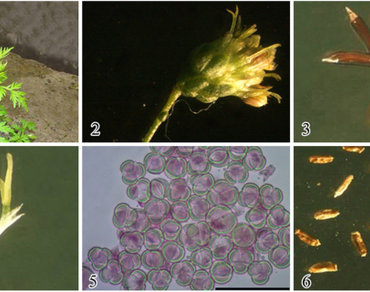Cytological plasticity: a trait adopted by Artemisia nilagirica (C.B. Clake) Pamp., a proliferant in NW Himalayas, J&K, India
Research Articles | Published: 19 January, 2022
Online ISSN : 2229-4473.
Website:www.vegetosindia.org
Pub Email: contact@vegetosindia.org
First Page: 392
Last Page: 403
Views: 739
Keywords:
Artemisia
, Breeding, Cytology, Flexible, Meiosis, Rootstock variation
Abstract
Artemisia L. is a cytologically flexible and medicinally important genus of tribe Anthemideae of family Asteraceae. It is widely distributed mainly across the Northern Hemisphere, with a major centre of diversification in Asia and only a few representatives in Southern hemisphere. World over, more than 500 species of this genus have been reported, out of which a total of 45 exist in India; 20 among these being reported in J&K state, India (Karthikeyan et al. 2009), where the present work has been carried out. The compilation is based on five populations of A. nilagirica sprawling at an altitudinal range of 332–1705 masl (Jammu, Rajouri, Poonch, Bhaderwah and Kud). The species is highly complex cytologically and capable of generating variations both through its meiotic as well as breeding system. Five populations could be segregated as three cytotypes with 2n = 18 (diploid), 2n = 32 and 34 (aneuploid) and 2n = 54 (hexaploid), all of them showing high degree of outbreeding. Although the chromosomal changes have an effect upon the seed set in this species in the form of reduced percentage of healthy seeds; little amount of variability that survives and adapts is maintained and ramified asexually through rootstock. Present study rests on details of various morphological characteristics, cytological structure, chromosomal behaviour and breeding system operative in this medicinally important species.

(*Only SPR Members can get full access. Click Here to Apply and get access)
References
Battaglia E (1955) Chromosome morphology and terminology. Caryologia 8:179–187
Besser WSJG (1835) Draunculi Seu de sectione IV ta et ultima Artemisiarum Linnaei. Bull De La Soc Imp Des Nat De Moscou 8:1–95
Bharti U, Gurmet R, Sharma E, Sharma N (2017) Genetic systems in Artemisia L. I: Artemisia tournefortiana, a species with high sexual reproductive efficiency. J Plant Dev Biol 9:657–661
Candolle AP (1837) Prodromus systematis naturalis regni vegetabilis. Pars VI, Paris
Charlesworth D (2006) Evolution of plant breeding system. Curr Biol 16:26–35
Gurmet R, Mir GJ, Bharti U, Sharma N (2017) Sexual reproductive efficiency of Artemisia sieversiana abounding Ladakh (TransHimalayan) Region in India. Bull Pure Appl Sci 36:10–21
Kalisz S, Vogler DW (2003) Benefits of autonomous selfing under unpredictable pollinator envirnments. Ecology 84:2928–2942
Kawatani T, Ohno T (1964) Chromosome numbers in Artemisia. Bull Natl Inst Hyg Sci (tokyo) 82:183–193
Matoba H, Nagano K, Hoshi Y (2007) The tendency of chromosomal evolution in some Japanese Artemisia using numerical analysis of karyotype. Cytologia 72(2):181–188
Mir GJ, Gurmet R, Sharma N (2014) Interpopulation variability in Artemisia glauca Pall. Ex Willd.—studies on three distinct cytotypes. Nucleus 58:95–100
Pellicer J, Garcia S, Granatje T, Hidalgo O, Korobkov AA, Dariimaa S, Valles J (2007a) Chromosome counts in Asian Artemisia L. (Asteraceae) species from diploids to the first report of the highest polyploidy in the genus. Bot J Linn Soc 153:301–310
Pellicer J, Garcia S, Granatje T, Hidalgo O, Korobkov AA, Dariimaa S, Valles J (2007b) Chromosome number in some Artemisia (Asteraceae, Anthemideae). species and genome size variation in its subgenera Dracunculus: Karyological, systematic and phylogenetic implications. Chromosom Bot 2:45–43
Pellicer J, Teresa G, Valles J (2011) Artemisia (Asteraceae): Understanding its evolution using cytogenetic and moleculer systematic tools, with emphasis on sub genus Dracunculus. Recent Adv Pharm Sci 9:199–222
Sharma I, Sharma E, Sharma N (2015) Resource allocation in relation to meiotic system in two species of Artemisia from North-West Himalayas. Caryologia 68:351–356
Stebbin GL (1971) Chromosomal evolution in higher plants. Edward Arnold Ltd., London
Valles J, Garnatje T (2005) Artemisia and its allies: genome organization and evolution and their biosystematic, taxonomical and phylogenetic implications in Artemisiinae and related subtribes (Asteraceae, Anthemideae). In: Sharma A (ed) Plant genome: biodiversity and evolution, Vol. 1B, phanerogams. Science Publishers, Enfield, pp 255–285
Wang WM (2004) On the origin and development of Atremisia (Asteraceae) in the geological past. Bot J Linn Soc 145:331–336
Zhen L, Chen S, Chen F, Fang W, Li J, Wang H (2010) Karyotype and meiotic analysis of five species in the genus Artemisia. Caryologia 63:382–390
Gurmet R, Bharti U, Mir GJ, Sharma N (2018) Cytological variability in Artemisia L. inhabiting North-West Himalayas: B chromosomes in Artemisia gmelini Weber ex Stechm. Cytology and Genetics
Acknowledgements
Authors are thankful to UGC-SAP (DRS-II) for financial assistance.
Author Information